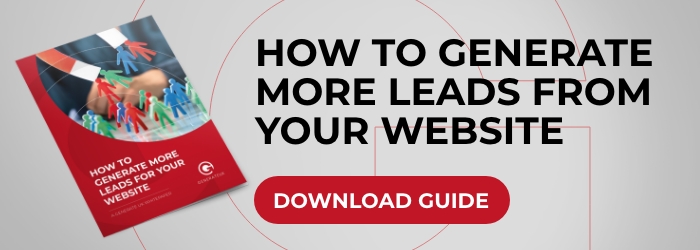Is your website optimised for lead generation?
In this three-part series, we will take you through some of the steps you can take to identify where your lead generation efforts are going wrong, and what you can do to fix it.

“Our website isn’t generating enough leads”
This is a common problem that customers often come to us to solve. They know that their website, and digital marketing activity, could be doing better, but they’re not sure what they need to do to get there.
There are many ways to improve your website’s lead generation capabilities, but first you need to diagnose what’s causing the problem in the first place.
The common barriers to effective lead generation
In our experience, we find that the majority of our client’s lead generation issues can be boiled down to three factors:
- The wrong visitors are coming to the website
- Potential customers cannot find the website
- The website is not optimised for lead generation
In this three-part series, we will take you through some of the steps you can take to identify where your lead generation efforts are going wrong, and what you can do to fix it.
The website is not optimised for lead generation
The final barrier we find to effective lead generation is websites that are not designed to encourage users to convert.
A great website is not just about looks (although this certainly helps), a website needs to consider a wide range of factors such as usability, user experience, its interface, above all your business goals and objectives.
If this wasn’t scoped from the outset as part of your website project, than chances are a new website, or at least major changes to your existing site, might be in order.
Prioritise the main action you want your visitors to make, and optimise the journey for it
One of the main reasons that websites fail to generate leads, is that they provide an overwhelming or complicated experience that has made it unclear on what it wants the user to do next.
To address this, think about the main action that you want users to take away from your website, and optimise the journey for it accordingly.
For example:
If you want users to call into your sales team, put your telephone number in your header so it’s always visible.
If the goal is to encourage visitors to sign up to your newsletter, ensure that they can easily do this across the website with carefully placed forms and messaging that matches the intent of the page.
If you want to get more demo requests, then ensure that call-to-action (CTA) buttons are dotted across all product pages to make it clear to users that this is the next step they should take.
Speaking of CTAs…

Ensure all pages have clear CTAs
When placing any CTA, always make sure it is in a prominent position and stands out to make it easier for your user to see it.
Be sure it doesn’t blend in with the background, and avoid using multiple colours within the button to prevent confusion.
Making the CTA clear and present will help to draw your reader’s attention to click the button or complete that action.
Also, be creative in what you’re telling your user to do; don’t rely on standard CTAs such as “learn more” or “get in touch”.
Instead consider adding what users will receive by clicking the button, such as:
- Download free guide
- Book 30-minute demo
- Get discount code
- See exclusive products
- Access secret sale
- Get more leads
This simple change of approach can make a big difference between your audience converting, and not converting.
Create content that’s accessible and easy to read

When creating your landing page or writing copy to entice customers, remember to keep it simple.
We lead busy lives, we don’t have the time to read reams of text, and don’t want to either, so be succinct and get to point.
A few paragraphs outlining the challenge your customer is facing, the benefits of solving it, and how you can help them do it will suffice.
Writing for the web is an art unto itself, so it’s important to get the basics right to make sure you are engaging your audience to read as much of your content as possible.
- Create bulleted lists
- Put important information near the beginning of sentences and paragraphs
- Highlight key points in bold
- Use plenty of descriptive subheadings to make sure scanners get the most vital information
- Don’t use jargon – speak
- Write in short paragraphs
- One idea per paragraph
- Create plenty of whitespace to guide the reader’s eyes towards the content
Shorten contact forms to only the necessary information
It is difficult to say exactly how long or short your contact form should be, as this will vary on a case by case basis. However, keep it as short as you possibly can.
You are likely to find that the shorter the form, the more leads you will accumulate as consumers prefer filling in a form which takes less time to complete.
If you have any optional boxes on your form, consider whether these can be removed to make the form shorter and more manageable.

Improve your site’s effectiveness with A/B testing
Split testing and experimentation is all about learning from your audience and how they want to interact with your business.
By comparing just one element, you can quickly learn what increases or decreases audience engagement, and you can make adjustments accordingly
This makes it an extremely useful activity for increasing your business’ lead generation.
There’s no one-size-fits-all when it comes to landing page design.
What’s succeeded for one campaign, may not succeed for another.
Instead, you should rely on trial and error to ensure that your page is engaging for potential customers.
Some of the elements you should consider testing are:
- Call to action
- Page heading
- Page layout
- Form length
- Copy length
- Main image
- Button design & colour
- Informal vs formal tone
There are a number of excellent split testing tools on the market, including those by HubSpot and Unbounce, however, the majority are pay to use tools.
For a free A/B testing to help your business experiment with different page variations, we recommend Google Optimize.
Integrated with Google Analytics, Google Optimize is an easy to use tool, which provides in-depth insights to overall user behaviour on your website without spending a penny!
Fix broken links, and improve the site speed and the mobile friendliness of your website

Broken links lead users to non-existent webpages, which, unsurprisingly, negatively affects their user experience.
It can also worsen your search engine rankings because crawlers may think that your website is poorly maintained or coded, which would affect their reputation if they were to guide users to a poor website.
You want to keep any micro-frictions on your site to a minimum, because over time they will add up.
Another important step in mitigating possible frustrations is to make sure your website loads as fast as possible.
Every second your user waits for a page to load is more time for them to become dissatisfied and potentially leave your website all together, potentially never to return.
This is also the case for poor mobile experiences.
Nearly 60% of all searches are now made on a mobile device. Optimising content for mobile is no longer a nice to have, it needs to be a priority focus of your user experience.
In fact, Google has made both a feature of its Web Vitals ranking factor, doubly emphasising the need to provide excellent user experiences.
Poor landing pages

Your landing page should be considered the most important area of your lead generation optimisation activities.
Where your user arrives on the website will be their first impression of your business, and potentially your last if they’re not engaged.
Your landing page needs to convey within 0.5 seconds of arriving:
- Who you are
- What you do
- How you can help
If it doesn’t; visitors will simply bounce off your website.
When creating landing pages for Google Ads, there are a number of best practices we recommend your business follows:
- Ensure the title of the page links to the headline of your advertising
- Don’t overload the user with actions
- Create dedicated landing pages for each audience segment – each will have different needs from a page.
- Keep the page clean and easy to read
- Tell visitors exactly what they’re going to get from completing a form
- Use social proof such as testimonials or customer logos
- Be mobile friendly

About Generate UK
We empower ambitious B2B companies to generate growth through creative marketing.
Our mission is to help companies understand the true value in digital marketing and set out to help those organisations develop and implement new technology and processes to deliver a growth marketing strategy in line with their goals.
Partnership is key to our approach. We work closely with you to identify what will drive growth for your business, and provide a range of digital marketing services to achieve it.
We remain the only UK marketing agency to be awarded the Customer Service Excellence+ Accreditation, demonstrating our commitment to our clients.